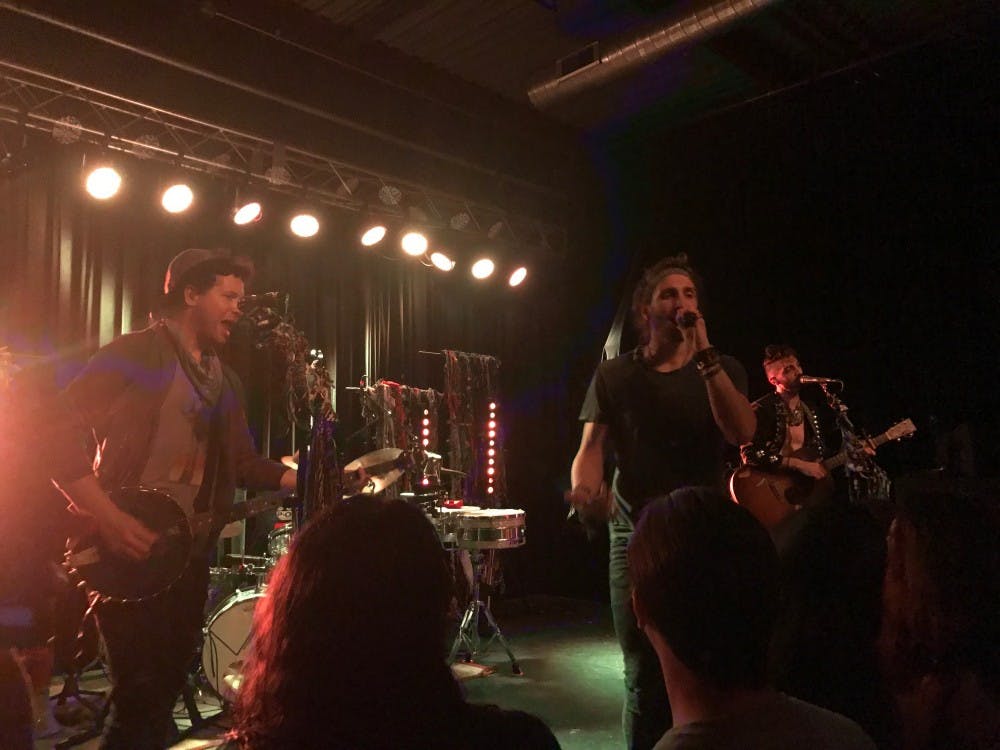American indie-folk band Magic Giant took the stage on Tuesday night at Cat’s Cradle Back Room. Known for their eclectic energy and banjo-delivering pop hooks, the Los Angeles trio consists of lead vocalist Austin Bisnow; Zambricki Li who plays the banjo, violin and harmonica and Zang who plays the acoustic guitar and cello.
Magic Giant released their self-titled EP "Magic Giant" in 2015 and their debut studio album "In the Wind" this past May. Amid this album release, Rolling Stone included the band in their list of "10 New Artists You Need To Know: June 2017." The band is best known for its chart topping single "Set On Fire," as well as for the song "Window."
Staff Writer Laura Shanahan met Bisnow in a coffeeshop and later spoke with the band members about how they recorded music in a Redwood tree, their efforts to help the environment and their connection with the audience.
The Daily Tar Heel: Welcome to Chapel Hill! How would you describe your typical pre-show routine?
Austin Bisnow: A lot of times in the day we do a VIP experience. Today we didn’t do that, but we did something similar — basically where we do an acoustic set for probably 40 people. So, today we did that in Durham at an ad agency, but a lot of times we’ll do it before the show. That kind of warms us up a little bit. Before that, we do a soundcheck, and then after that we’ll usually try to get some food. We’ll come back to the greenroom, set up a couple of my things for after the show — because after I’m dripping sweat, I need to change, wash off and then we try to say hi to people as soon as we can. Our biggest pre-show ritual is taking a collective breath. It’s like a “Sh…Ah” but then on the third or fourth one we go “Ah... freak out!” And then it’s showtime.
DTH: Congratulations on your debut album, "In the Wind." Could you tell me a little bit about the process behind making this album?
AB: This album was much different than anything we’ve done before. We bought a shuttle bus and converted it, added solar panels and made it our solar-powered mobile recording studio. Basically, we looked at a map of our summer festivals — summer of 2016 — and we were like, “Woah, we’re going to the most beautiful parts of the country.” We also had a collection of songs that we’d been performing live and wanted to put them together for an album. So we said, let’s not book shows during the week; let’s just play these festivals on the weekend and book studio time in nature. You know, not actually booked studio time.
But when we’re in the Redwoods, let’s go find a place. We found a tree — the inside of the tree was probably almost as big as this room — and we recorded banjo in there. We found this tunnel that was two miles in Washington state, and we recorded some vocals in there for this long reverb. We recorded in a wildfire field in Crested Butte, Colorado, and in a barn outside of Toronto at a farm. Just all these different places that had a cool acoustics to them that you don’t necessarily find in the studio, or that studios are trying to emulate, but we just went out and did it. There were challenges… first of all, like rangers trying to kick us out of Moab, rain, wind, birds.
DTH: Did you keep that sound in your album?



